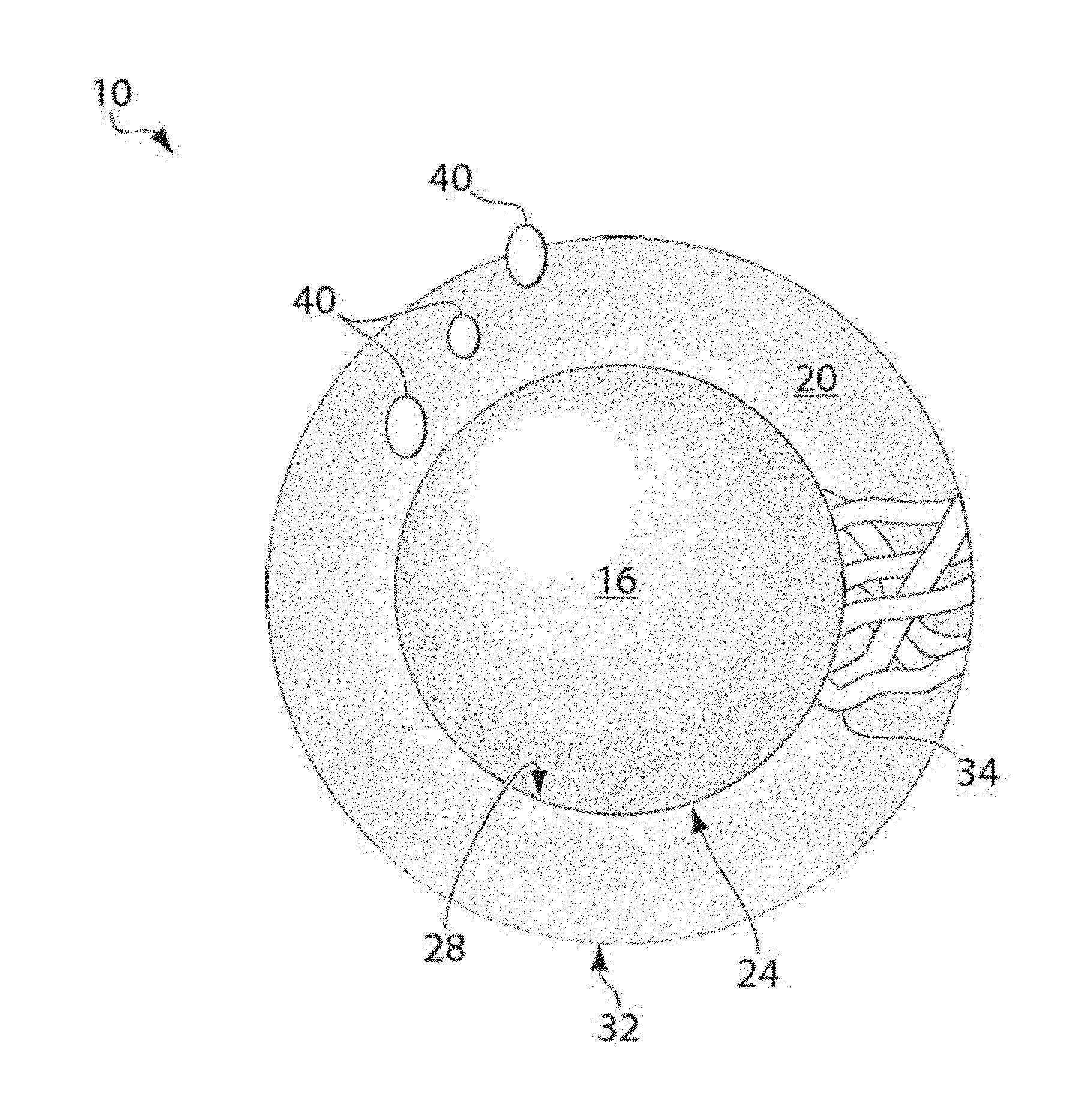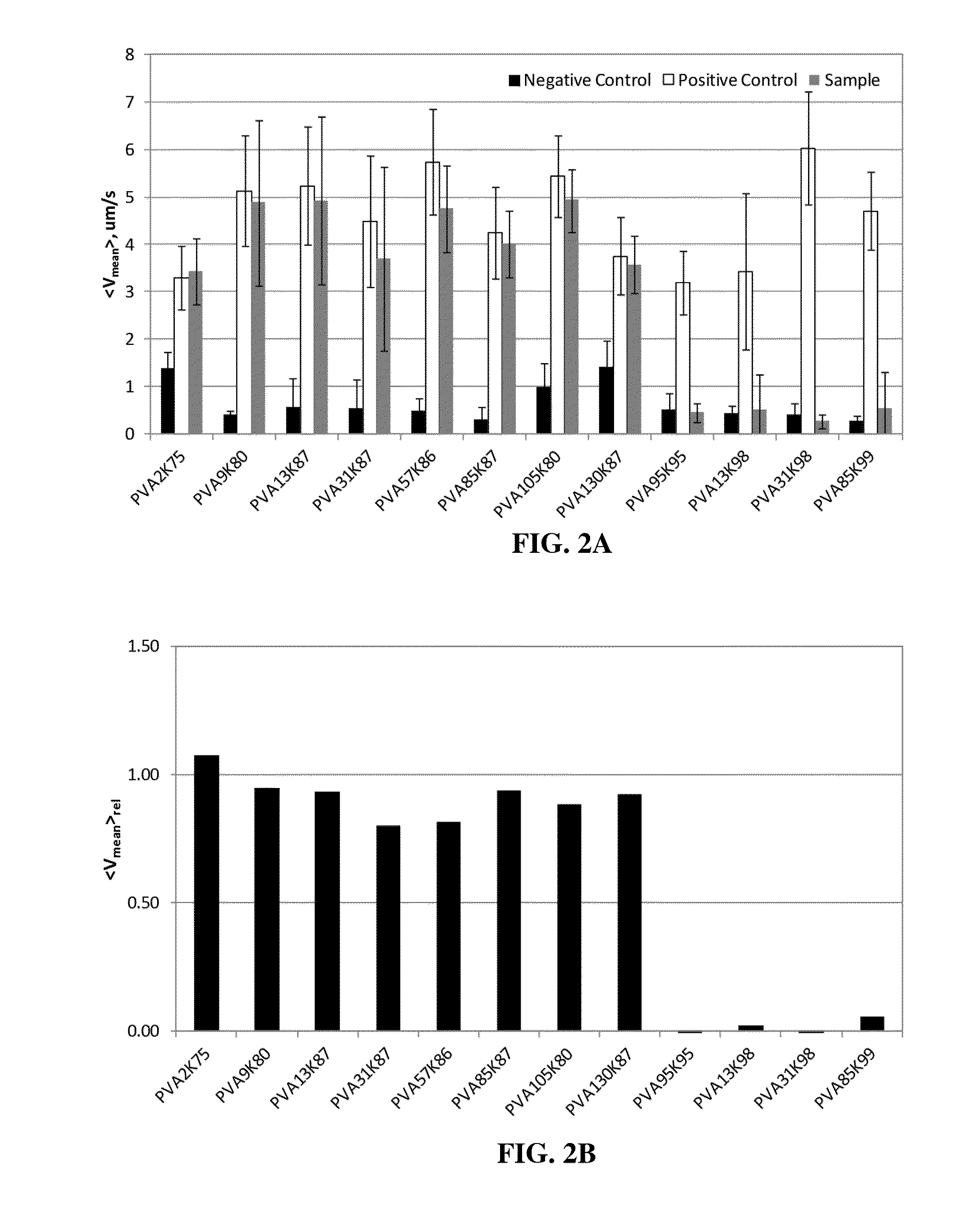Compositions and methods utilizing poly(vinyl alcohol) and/or other polymers that aid particle transport in mucus
a technology of polyvinyl alcohol and polymer, which is applied in the direction of capsule delivery, peptide/protein ingredients, microcapsules, etc., can solve the problems of a handful of surface coatings and inability of conventional nanoparticles to cross mucosal barriers, and achieve the effect of facilitating mucus penetration
- Summary
- Abstract
- Description
- Claims
- Application Information
AI Technical Summary
Benefits of technology
Problems solved by technology
Method used
Image
Examples
example 1
[0183]The following describes a non-limiting example of a method of forming mucus-penetrating particles from pre-fabricated polymeric particles by physical adsorption of certain poly(vinyl alcohol) polymers (PVA). Carboxylated polystyrene nanoparticles (PSCOO) were used as the prefabricated particle / core particle with a well-established strongly mucoadhesive behavior. The PVAs acted as surface-altering agents forming coatings around the core particles. PVA of various molecular weights (MW) and hydrolysis degrees were evaluated to determine effectiveness of the coated particles in penetrating mucus.
[0184]PSCOO particles were incubated in aqueous solution in the presence of various PVA polymers to determine whether certain PVAs can physically (non-covalently) coat the core particle with a mucoinert coating that would minimize particle interactions with mucus constituents and lead to rapid particle penetration in mucus. In these experiments, the PVA acted as a coating around the core p...
example 2
[0191]The following describes a non-limiting example of a method of forming mucus-penetrating particles by an emulsification process in the presence of certain poly(vinyl alcohol) polymers (PVA). Polylactide (PLA), a biodegradable pharmaceutically relevant polymer was used as a material to form the core particle via an oil-in-water emulsification process. The PVAs acted as emulsion stabilizers and surface-altering agents forming coatings around the produced core particles. PVA of various molecular weights (MW) and hydrolysis degrees were evaluated to determine effectiveness of the formed particles in penetrating mucus.
[0192]PLA solution in dichloromethane was emulsified in aqueous solution in the presence of various PVA to determine whether certain PVAs can physically (non-covalently) coat the surface of generated nanoparticles with a coating that would lead to rapid particle penetration in mucus. In these experiments, the PVA acted as an surfactant that forms a stabilizing coating ...
example 3
[0197]The following describes a non-limiting example of a method of forming mucus-penetrating non-polymeric solid particles by nanomilling in the presence of certain poly(vinyl alcohol) polymers (PVA). Pyrene, a model hydrophobic compound, was used as the core particle processed by a nanomilling. The PVA acted as nanomilling aids facilitating particle size reduction of the core particles and surface-altering agents forming coatings around the core particles. PVA of various molecular weights (MW) and hydrolysis degrees were evaluated to determine effectiveness of the nanomilled particles in penetrating mucus.
[0198]Pyrene was nanomilled in aqueous dispersions in the presence of various PVA to determine whether PVAs of certain MW and hydrolysis degree can: 1) aid particle size reduction to several hundreds of nanometers and 2) physically (non-covalently) coat the surface of generated nanoparticles with a mucoinert coating that would minimize particle interactions with mucus constituent...
PUM
| Property | Measurement | Unit |
|---|---|---|
| molecular weight | aaaaa | aaaaa |
| molecular weight | aaaaa | aaaaa |
| molecular weight | aaaaa | aaaaa |
Abstract
Description
Claims
Application Information
 Login to View More
Login to View More - R&D
- Intellectual Property
- Life Sciences
- Materials
- Tech Scout
- Unparalleled Data Quality
- Higher Quality Content
- 60% Fewer Hallucinations
Browse by: Latest US Patents, China's latest patents, Technical Efficacy Thesaurus, Application Domain, Technology Topic, Popular Technical Reports.
© 2025 PatSnap. All rights reserved.Legal|Privacy policy|Modern Slavery Act Transparency Statement|Sitemap|About US| Contact US: help@patsnap.com



